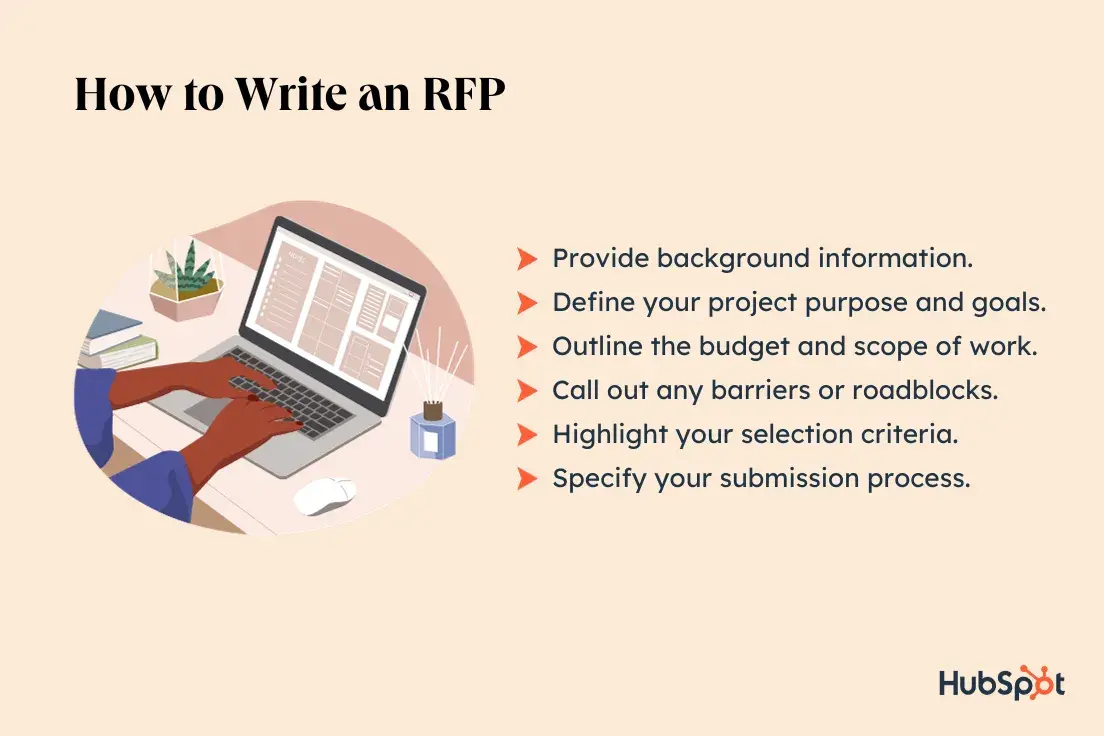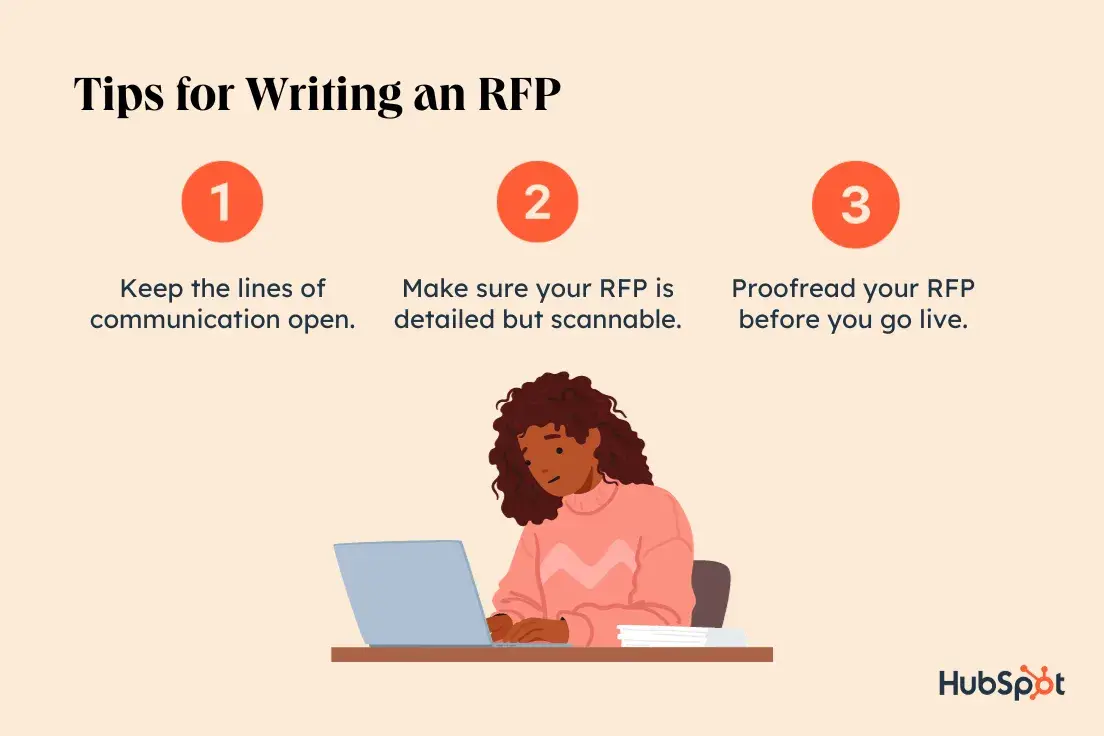That’s OK because I have a few tips up my sleeve to make your RFP development process a little less daunting (and a little more fun, hopefully).
Table of Contents
What's an RFP?
A request for proposal (RFP) is a written announcement designed to collect bids from vendors for a specific project. A good RFP clearly outlines the project details for both parties including what needs to be delivered, when, and for how much.
Since I struggle living in a world with a million acronyms, let’s clear up the difference between an RFP and RFI before we continue.
RFP vs RFI
A request for information (RFI) is used by companies to get a sense of what solutions are available on the market. A request for proposal (RFP) invites vendors to submit bids so companies can make final decisions for a specific business project.
Here’s the TL;DR — If your business has a project and you need external support, and you already know what type of vendor you’re looking for, you can use an RFP to shop around.
When I worked for a small health communication firm, one of our government clients wanted us to create an educational video series for them.
I developed an RFP on their behalf to solicit proposals from video production companies since we didn’t have the capabilities to complete this work in house.
Hold on to this example — I’ll use it to walk you through the RFP writing process.
How to Write an RFP
As a reminder, here’s the example we’re using for this walkthrough: AJC Health is developing an RFP on behalf of a government client, DoGoodGov, for educational video production services.
(The company names are made up, but the experience is real … I promise.)

1. Provide background information.
Your RFP should always start with an introduction and overview of your business. This helps set the stage for potential vendors and allows them to better understand who they’ll be working with.
Pro tip: I like to keep this section brief. Just introduce your business, highlight your mission, and discuss the products and services you provide.
Example:
AJC Health is a health communication firm based in Washington, DC. Our mission is to empower teens and young adults to lead healthier lives.
For over 10 years, we’ve helped clients achieve their goals by providing marketing and communications services including campaign development, copywriting, and multimedia project support.
2. Define your project purpose and goals.
After you introduce yourself, provide an overview of the project. This is your first opportunity to describe what you’re hoping to accomplish and the areas of expertise you’re looking for.
I like to think of this section as a way to help vendors better understand your priorities so they can tailor their proposals accordingly.
Pro tip: I’d recommend keeping this section clear and concise. Focus on the purpose of the RFP, the type(s) of vendors you’re looking for, and your goals. You’ll have an opportunity later to provide specific details about the scope of work later.
Example:
The purpose of this Request for Proposals (RFP) is to invite businesses who specialize in video production, live action, animation, and multimedia for educational purposes to submit proposals to our company.
We’re currently seeking qualified vendors to support the development of a public health video series on behalf of DoGoodGov. Our goal is to build brand awareness, drive web traffic, and increase our YouTube marketing ROI.
3. Outline the budget and scope of work.
In the last step, we described the project at a high level. This section is where you can get into the weeds a little bit. State your budget and describe the specific services you need.
For me, it’s helpful to compare this section to the “Job Responsibilities” section in a job description. Give a complete snapshot of what the role entails.
Pro tip: You can take various approaches when describing the services you’re seeking in an RFP, but I recommend incorporating bullet points or breaking up your information so that it’s easy for vendors to scan.
Example:
The budget for this project is $12,750.
The selected firm will be responsible for the ideation, production, and delivery of a three-part video series to educate teens and young adults about the benefits of living a healthy lifestyle.
Tasks include but may not be limited to the following criteria:
- Ideating video concepts
- Writing and editing video scripts
- Multimedia (audio/video) content development
- Capturing, importing, and organizing raw media
- Editing video footage and audio files
- Creating static and motion graphics
- Adding music, voice-over, and sound effects
- Delivering multi-format video files (e.g., YouTube, social media, web)
- Meeting the requirements of Section 508 Compliance for video
- General account management
- Other assistance as required
4. Call out any barriers or roadblocks.
Here, you’ll want to mention any challenges specific to your project. This may include elements like limited resources or specialized requirements that the average vendor may not have or easily obtain.
This may seem counterintuitive, but I’ve found that this helps you eliminate unsatisfactory bidders and figure out which vendors have the skills to tackle those challenges.
Pro tip: It’s crucial to be transparent here. Otherwise, vendors may not fully understand the potential difficulties that may arise. This lack of knowledge could lead to delayed timelines, increased costs, or worse — an unsuccessful project.
Example:
As a federal entity, DoGoodGov requires all materials, including multimedia content, to meet the requirements of Section 508 Compliance. Vendors must have specialized knowledge in 508-Compliance for video production.
5. Highlight your selection criteria.
Now it’s time to specify which skills, services, and market expertise are required for consideration. This is the time to get specific, just like we did in the scope of work section.
Some examples of selection criteria that you can specify in an RFP are experience, qualifications, cost, availability, and technical compatibility.
Pro tip: When I’m building out this section, I focus on the objective criteria that my business will use to, well, pick a winning bid. I’ve found that clear selection criteria helps increase your chances of receiving proposals that actually meet your needs.
Example:
The ideal vendor:
- Has experience in producing high-quality videos across various formats such as live-action, animation, screencast, whiteboard, and educational video
- Has a clear process from ideation, production, revision, and final delivery
- Has experience creating videos for educational purposes (public health knowledge and experience is a plus)
- Has demonstrated knowledge in the requirements of Section 508 Compliance
- Can provide a highly responsive, collaborative, and transparent communication process
6. Specify your submission process.
The selection criteria and the submission process outline go hand-in-hand to ensure you end up with a strong collection of proposals.
Tell vendors where to submit their bids and to whom, and give them a timeline that includes the submission deadline, date for final selection, and project completion date. Then, tell them exactly what you want them to submit.
Pro tip: I’d treat the submission process as a test for who’s capable of meeting your requirements. If a vendor can’t complete all elements of your proposal, you probably can’t trust them to finish your project, either.
Example:
Submission Information
Submissions may be sent via mail or electronically by the submission deadline.
- Project Name or Description: Video Production Services
- Company Name: AJC Health
- Address: 123 Howie Ave.
- City, State, Zip Code: Silver Spring, MD 20906
- Procurement Contact Person: Alana Chinn
- Telephone Number of PCP: 123-456-7890
- Email Address of PCP: achinn@consulting.com
- Fax Number: N/A
Submission Timeline
Proposals must be submitted by February 10th. The award will be granted no later than March 1st. Final video delivery must occur by June 30th.
Submission Criteria
A submission must, at a minimum, include the following elements:
- Description of the firm that includes a general overview, names and credentials of creative team, number of full-time employees.
- A one-page narrative outlining the firm’s strengths and distinguishing skills or capabilities as they might relate to AJC Health.
- A representative selection of multi-channel video content, audio samples, and project management plans created for current and past clients.
RFP Template
Below, I’ve included one of my favorite RFP templates. (It’s ours at HubSpot, so I may be a little biased.)
Download a free, editable RFP template.
You can use this template to build your initial structure, but I’d recommend tailoring your RFP to best articulate your company’s needs.
RFP Sample
1. Introduction
Background
AJC Health is a health communication firm based in Washington, DC. Our mission is to empower teens and young adults to lead healthier lives.
For over 10 years, we’ve helped clients achieve their goals by providing marketing and communications services including campaign development, copywriting, and multimedia project support.
Project Overview
The purpose of this Request for Proposals (RFP) is to invite businesses who specialize in video production, live action, animation, and multimedia for educational purposes to submit proposals to our company.
We’re currently seeking qualified vendors to support the development of a public health video series on behalf of DoGoodGov. Our goal is to build brand awareness, drive web traffic, and increase our YouTube marketing ROI.
2. Budget and Services Requested
Budget
The budget for this project is $12,750.
Scope of Work
The selected firm will be responsible for the ideation, production, and delivery of a three-part video series to educate teens and young adults about the benefits of living a healthy lifestyle.
Tasks include but may not be limited to the following criteria:
- Ideating video concepts
- Writing and editing video scripts
- Multimedia (audio/video) content development
- Capturing, importing, and organizing raw media
- Editing video footage and audio files
- Creating static and motion graphics
- Adding music, voice-over, and sound effects
- Delivering multi-format video files (e.g., YouTube, social media, web)
- Meeting the requirements of Section 508 Compliance for video
- General account management
- Other assistance as required
3. Barriers to Completion
As a federal entity, DoGoodGov requires all materials, including multimedia content, to meet the requirements of Section 508 Compliance. Vendors must have specialized knowledge in 508-Compliance for video production.
4. Selection Criteria
The ideal vendor:
- Has experience in producing high-quality videos across various formats such as live-action, animation, screencast, whiteboard, and educational video
- Has a clear process from ideation, production, revision, and final delivery
- Has experience creating videos for educational purposes (public health knowledge and experience is a plus)
- Has demonstrated knowledge in the requirements of Section 508 Compliance
- Can provide a highly responsive, collaborative, and transparent communication process
5. Submission Process
Contact Information
Submissions may be sent via mail or electronically by the submission deadline.
- Project Name or Description: Video Production Services
- Company Name: AJC Health
- Address: 123 Howie Ave.
- City, State, Zip Code: Silver Spring, MD 20906
- Procurement Contact Person: Alana Chinn
- Telephone Number of PCP: 123-456-7890
- Email Address of PCP: achinn@consulting.com
- Fax Number: N/A
Timeline
Proposals must be submitted by February 10th. The award will be granted no later than March 1st. Final video delivery must occur by June 30th.
Submission Criteria
A submission must, at a minimum, include the following elements:
- Description of the firm that includes a general overview, names and credentials of creative team, number of full-time employees.
- A one-page narrative outlining the firm’s strengths and distinguishing skills or capabilities as they might relate to AJC Health.
- A representative selection of multi-channel video content, audio samples, and project management plans created for current and past clients.
Request for Proposal Examples
Now, just explaining to you the formatting of an RFP probably won't paint you the entire picture, so to better help you understand the range and structuring — we found some real examples for you to familiarize yourself with.
1. Brand Reposition Campaign RFP
The curators of the University of Missouri, on behalf of the University of Missouri-Columbia, was seeking proposals from marketing firms to develop a brand repositioning campaign. The selected firm would conduct market research, competitive analysis, and perception studies to create a brand strategy, style guide, messaging framework, and implementation roadmap. This initiative aims to differentiate the university from competitors and establish consistent brand expression, supporting growth.
2. Multi-Channel Marketing Campaign RFP
The Texas State Affordable Housing Corporation (“TSAHC”) was issuing this Request for Proposals (“RFP”) to identify and contract for professional services to provide multicultural marketing, advertising, and creative services to support the promotion of TSAHC’s home buyer programs in Harris County.
3. Website Redesign and Development RFP
The State Bar of California sought proposals to optimize and redesign its public-facing websites. The proposal focused on improving user experience, optimizing for mobile devices, modernizing design, and ensuring accessibility compliance. Proposals recommended appropriate web technologies and content management solutions. Contract award expected by April 25, 2024, with work commencing by May 22, 2024.
4. Supply Chain Optimization Consulting RFP
The Global Alliance for Improved Nutrition seeks proposals to develop a training manual on supply chains and logistics practices for agrifood MSMEs. The manual should focus on cold chain management for perishable products, covering sourcing, supplier development, inventory management, and distribution planning. The resource will help MSMEs optimize procurement, improve inventory control, and enhance distribution efficiency to strengthen overall supply chain management in the agrifood sector.
5. Commercial Office Building Construction RFP
The State Bar of California was seeking qualified contractors for interior remodeling at the Office of Admissions suite. The project included remodeling multiple storage and work rooms, plus expanding an existing meeting room. Architectural drawings have been completed. Interested contractors encouraged to submit comprehensive proposals detailing their approach to this renovation project.
Tips for Writing an RFP
Here are three tips from my arsenal to help you optimize your RFPs to achieve a high response rate from vendors.

1. Keep the lines of communication open.
Providing access to a point of contact shows that your company is invested in the vendor response process and helps you proactively establish a rapport.
And if you have flexibility in your timeline, I’d also recommend that you encourage prospective vendors to ask questions and seek clarification before submitting a proposal.
The more they understand your needs, the better their proposals will be.
2. Make sure your RFP is detailed but scannable.
If I was a vendor, I’d be a lot less likely to respond to your RFP if the project details are insufficient or unclear. However, you’ll want to strike the balance between providing enough but not too much detail.
I like to make sure each of my sections are well-defined, and the document is easily scannable. To do this, I take full advantage of formatting options, like bullet points and headings.
This allows me to provide the necessary information in a digestible way.
3. Proofread your RFP before you go live.
Last but never least? Proofread your RFP — then proofread it again. Why? Because even small mistakes could derail project timelines.
Can you imagine if you missed a zero in your budget details, or included the wrong date for your proposal deadline? Both could force a restart of the entire RFP process and waste precious time.
Just the thought of that alone is enough to make sure I never skip this step.
Go Forth and RFP
See, that was kind of exciting … right? Well, at the very least, I hope this helped simplify the RFP process for you.
Editor's note: This post was originally published in June 2018 and has been updated for comprehensiveness.
RFPs
.png?width=112&height=112&name=image%20hackathon%20%E2%80%93%20square%20(66).png)

.png)

![RFPs Explained: Get the Best Bids From Potential Vendors [+ Examples, Use Cases, and Templates]](https://53.fs1.hubspotusercontent-na1.net/hubfs/53/RFP-1-20240917-6060489.webp)



